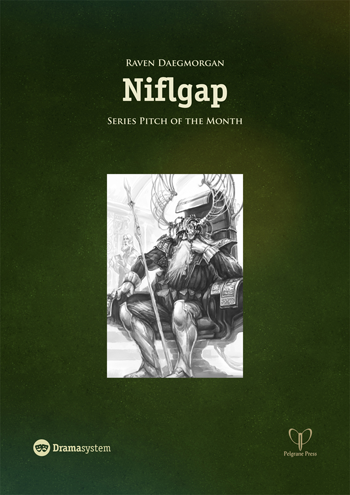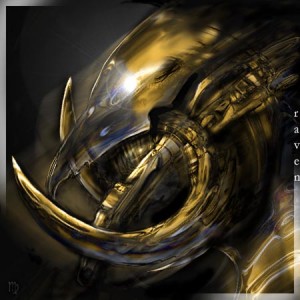Niflgap
Niflgap invites you to sail the black tides of the cosmos as the universe dies around you. The fractious Norse gods have set forth in starships from lonesome Midgaard, hoping to find salvation in the void, where armies of the hungry dead writhe endlessly beneath black suns.
An official “Series Pitch of the Month” with 2000 words of setting, prompts, and characters for use with for Robin Laws’ Hillfolk DramaSystem. Published in 2014 by Pelgrane Press, Niflgap is also included in a collection of twelve other official Series Pitches. Both can be purchased from the Pelgrane Publishing, Ltd. storefront.
Will you save the cosmos, or will you fall prey to the wolves and giants of Ragnarok…or worse, to yourselves?

Man has traveled into the Abyss above searching for truth, and found the truth beyond Earth is terrifying beyond compare, for space is vast, empty, and dead, and humanity is utterly alone amidst the horrors that crawl through the darkness between stars and writhe as endless armies upon dead worlds beneath dim, black suns.
Alone with his nightmares, there remains one shining hope the dreams and needs of a world rest upon: can man find the rainbow bridge to the gods?

The History of Dead*Space
I originally mentioned this project during a design discussion on the Forge in 2004, and discussed pieces of it over the next few years. While the core of the setting has been solid since I first dreamed it up, I’ve spent years trying to find or develop the right set of mechanical tools for play.
Hence the excessive delay in design and release; nothing yet has adequately fit the themes of the project and experience I’m aiming to help players reproduce.
That a video game company took the name for one of their own similarly-themed products in 2008 also significantly slowed the work I had been doing on the project, due the depression that discovery threw me into, and I remain uncertain as to when the fully-realized project might emerge due my concerns and frustrations with the potential, perhaps phantasmal, legal issues and inevitable perceptual ones.
The idea for Dead*Space was conceived during the painting of the illustration above, titled “Helm of the Dead Ones”, and midwifed into being by memories of a cartoon (Ulysses 31) from my childhood about a spaceship sucked through a black hole into a solar system where the surviving crew had to face the trials of the Odyssey and mythological creatures from the Greek myths.
It was originally meant to be a game about the intersections and conflict of science & religion, with a very heavy influence from ancient Norse myth and culture, and the Viking aesthetic, about a world united in a singular goal to survive, reliant on often-unreliable heroes who sought adventure, fame, and honor, gone questing in search of something no one is certain even exists, while facing an unknowable, faceless doom.
A Taste of the Game
The stars themselves are dying. There are fewer every year.
Mankind had spread to the skies, traversed the deadly seas between worlds, to other stars and other worlds. Yet across all the centuries he found…nothing. No life but himself, and perhaps the spirits he carried with him. An empty universe. Man was alone. Alone but for the faceless wolves, the devourers of stars, the unknowable force which killed them and turned them black.
He watched as the stars failed. Then the worlds of men began to die, their suns turning lightless and foul in moments, leaving a million corpses — in stations and ships and among the struggling colonies, dead yet not, become armies writhing beneath black suns, hungry, hateful ghosts prowling whole regions of dead space, where even the eternal background song of creation — the echoes of radiation hissing and crackling — was ceased.
…
Man flies his ravens to the corners of time-and-space, seeking to gain the notice of and find audience with the gods who abandoned him in a dead universe. They seek passage across the rainbow bridge to Valhal and the realm of the creators, to make themselves known, to show themselves, to be worthy, to survive, to be united with their gods, to save Midgaard itself.
But Fenrir prowls the void, stealing the minds and souls of men, and the devourers Skoll and Hati seek to swallow all light and matter, leaving emptiness beyond which lurk the flames of Muspel and its terrible king.
…
- The Great Void : Ship’s Thane Skilf Stagurson mounted an expedition into this region — a barren, empty, hole in the cosmos of unimaginable size seeming to hold nothing — for he believed the great beast responsible for devouring the universe lived there, that deep in its heart was the wolf’s lair. His rousing speech to the crew who rode with him was recorded by the skalds of the temple and its runes kept in the Uppsalan Archive.
- The Autumn Protocol : A pillar of modern space-faring law developed by the renowned karl, Sagan Cole, in order to protect the blue jewel of Midgaard from the predations of the wolves. The protocol states the following three laws: once a ship has gone a-viking into the Abyss Above, it may never return to Midgaard, lest it lead the wolves home and life be utterly extinguished from the cosmos…